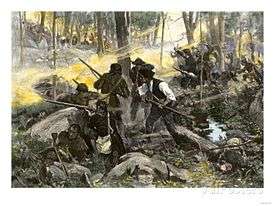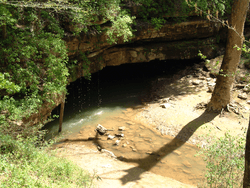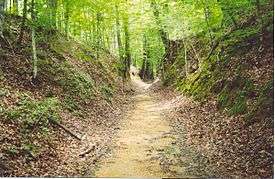Harpe brothers

| Micajah "Big" Harpe | |
|---|---|
| Born |
Joshua Harper Before 1768 (probably, c. 1748) Scotland, Kingdom of Great Britain or Orange County, Province of North Carolina (British Royal Colony), British North America, British Empire, present-day Orange County, North Carolina |
| Died |
August 1799 (aged 31-51) Muhlenberg County, Kentucky |
| Cause of death | murder by decapitation with knife |
| Resting place | unknown |
| Nationality | American |
| Other names | Micajah Roberts |
| Occupation | horse thief, bandit, burglar, highwayman, river pirate, plantation overseer, soldier, frontiersman |
| Known for | One of the first known serial-killers in America |
| Spouse(s) | Susan Wood, Maria Davidson (alias Betsy Roberts) |
| Children | 4 |
| Parent(s) | William Harper or John Harper |
| Relatives | Wiley Harpe (brother or cousin) |
| Wiley "Little" Harpe | |
|---|---|
| Born |
William Harper Before 1770 (probably, c. 1750) Scotland, Kingdom of Great Britain or Orange County, Province of North Carolina (British Royal Colony), British North America, British Empire, present-day Orange County, North Carolina |
| Died |
February 8, 1804 (aged 29-49) Old Greenville, Jefferson County, Mississippi Territory |
| Cause of death | execution by hanging |
| Resting place | unknown |
| Nationality | American |
| Other names | Wiley Roberts, John Setton, John Sutton, John Taylor |
| Occupation | horse thief, bandit, burglar, highwayman, river pirate, plantation overseer, soldier, frontiersman |
| Known for | One of the first known serial-killers in America |
| Spouse(s) | Sarah "Sally" Rice |
| Children | 4 |
| Parent(s) | William Harper or John Harper |
| Relatives | Micajah Harpe (brother or cousin) |
Micajah "Big" Harpe, born Joshua Harper (before 1768 (probably, c. 1748) – August 1799) and Wiley "Little" Harpe, born William Harper (before 1770 (probably, c. 1750) – February 8, 1804), were serial killers, murderers, highwaymen, and river pirates, who operated in Tennessee, Kentucky, Illinois, and Mississippi, in the late eighteenth century. The Harpes' crimes appear to have been motivated more by blood lust, than financial gain. They are most likely the United States' first known serial killers, reckoned from the colonial era forward.[2] The Harpe Brothers are credited with having killed thirty-nine people, and may have killed as many as fifty.
Early life
It is difficult to differentiate the facts about the Harpe Brothers from the later legends of their exploits.
The Harpes were born in Orange County, North Carolina to Scottish parents.[3] Micajah was probably born in or before 1768 and Wiley in or before 1770.[4] It is possible they were actually first cousins named Joshua and William Harper who later took the alias Harpe and emigrated from Scotland in 1759 or 1760. According to this theory their fathers were brothers, John and William Harper, who settled in Orange County, North Carolina, between 1761 and 1763.[5]
Prior to the American Revolution, their fathers, the Harper brothers, may also have been North Carolina Regulators, involved in the War of the Regulation or "Regulator War", which occurred between 1765-1771, opposing the continuing royal government interference by colonial officials in the Province of North Carolina. During the American Revolutionary War, the Harpes' fathers tried to join the Patriot American forces but were shunned from participating because of their earlier associations with British loyalists.[6] The terrible treatment of the Harper family by hostile, Patriot neighbors may have contributed to Big and Little Harpe's feelings of persecution and their desire for revenge.[7]
Big Harpe later traveled in the company of two women, Susan and Betsey/Betty Roberts, possibly sisters, both of whom bore him children.[7] Little Harpe married Sally Rice, the daughter of a Baptist minister.[8]
Around April or May 1775, the young Harper cousins left North Carolina and went to Virginia to find overseer jobs on a slave plantation.

Involvement in the American Revolutionary War and Indian Wars
Little is known of the Harpes' whereabouts at the outbreak of the American Revolution. According to the eyewitness account of Captain James Wood, they joined a Tory rape gang in North Carolina. These gangs took advantage of the war by raping, stealing, murdering, and burning and destroying property, especially farms of Patriot colonists. The Harpes' gang took part in the kidnapping of three teenage girls, with a fourth girl being rescued by Captain Wood.[9]
Captain Wood's son was patriot soldier Frank Wood, who was the older brother of Susan Wood Harpe, later kidnapped and married by Micajah "Big" Harpe. Frank Wood claimed to have seen the Harpe brothers serving "loosely" as Tory militia under the command of Lieutenant Colonel Banastre Tarleton's British Legion at the Battles of Blackstocks in November 1780 and Cowpens in January 1781. They also appeared at the Battle of Kings Mountain in October 1780, under British commander Major Patrick Ferguson.
Following the decisive British defeat by Patriot forces at Yorktown in 1781, the Harpes left North Carolina, dispersing with their Indian allies, the Chickamauga Cherokees, to Tennessee villages west of the Appalachian Mountains. On April 2, 1781, they joined war parties of four hundred Chickamauga to attack the Patriot frontier settlement of Bluff Station at Fort Nashborough (now Nashville, Tennessee), which would be assaulted by them again on either July 20, 1788, or April 9, 1793. On August 19, 1782, the Harpes accompanied a British-backed Chickamauga Cherokee war party to Kentucky at the Battle of Blue Licks where they helped to defeat an army of Patriot frontiersmen led by Daniel Boone.
During the Harpe brothers' early frontier period, among the Chickamauga Cherokee, they lived in the village of Nickajack, near Chattanooga, Tennessee, for approximately twelve or thirteen years. During this span of time, they kidnapped Maria Davidson and later Susan Wood and made them their women. In 1794, the Harpes and their women abandoned their Indian habitation before Nickajack was destroyed in a raid by American settlers. The Harpe brothers would later relocate to Powell's Valley, around Knoxville, Tennessee, where they stole food and supplies from local pioneers. The whereabouts of the Harpes are unknown between the summer of 1795 and spring of 1797, but by spring they were dwelling in a cabin on Beaver's Creek near Knoxville.
The Harpes may have disguised their Tory past from their Patriot neighbors by changing their original name of "Harper," which was a common Loyalist name in Revolutionary War-era North Carolina.
On June 1, 1797, Wiley Harpe married Sarah Rice, which was recorded in the Knox County, Tennessee marriage records. Sometime during 1797, the Harpes would begin their trail of death in Tennessee, Kentucky, and Illinois.



Atrocities and serial murders
The Harpes confessed to the killing of a confirmed thirty-nine people, but the estimated combined total (including unknown victims) may number more than fifty. What follows are the accounts of a few of the murders the two committed.
In 1797, the Harpes were living near Knoxville, Tennessee. They were driven from the town after being charged with stealing hogs and horses. They were also accused of murdering a man named Johnson, whose body was found in a river, covered in urine, ripped open, the chest cavity filled and weighted down with stones. This became a regular corpse disposal method and signature characteristic of the Harpes' serial killings. They butchered anyone at the slightest provocation, even babies.[6]
From Knoxville, the Harpes fled north into Kentucky. They entered the state on the Wilderness Road near the Cumberland Gap. They are believed to have murdered a peddler named Peyton, taking his horse and some of his goods. In December, they murdered two travelers from Maryland. Next, a man named John Langford, who was traveling from Virginia to Kentucky, turned up dead and a local innkeeper pointed the authorities to the Harpes. The criminal pair was pursued, captured, and jailed in Danville, Kentucky, but they managed to escape. When a posse was sent after them, the young son of a man who assisted the authorities was found dead and mutilated in retaliation by the Harpes.[10]
On April 22, 1799, Kentucky Governor James Garrard placed a three-hundred dollar reward on each of the Harpes' heads. Fleeing northward, the Harpes killed two men named Edmonton and Stump. When they were near the mouth of the Saline River in southern Illinois they came upon three men encamped there and killed them. The pair then made their way to Cave In The Rock, on the southern Illinois, a stronghold of the river pirate and criminal gang leader Samuel Mason. A posse had been aggressively pursuing them, but stopped just short of the cave, on the opposite shore in Kentucky.
With their wives and three children in tow, the Harpes holed up with the Samuel Mason Gang, who preyed on slow-moving flatboats making their way along the Ohio River. While the Mason Gang could be ruthless, even they were appalled at the actions of the Harpes. After the murderous pair began to make a habit of taking travelers to the top of the bluff, stripping them naked, and throwing them off, the Mason Gang forced the Harpe brothers to leave.
The Harpes then returned to eastern Tennessee, where they continued their vicious murder spree. They killed a farmer named Bradbury, a man named Hardin, and a boy named Coffey in July 1798. Soon more bodies were discovered, including those of William Ballard, who had been disemboweled and thrown in the Holton River; James Brassel, who had his throat viciously slashed and was discovered on Brassel's Knob; and John Tully. John Graves and his teenage son were found dead with their heads axed in south central Kentucky. In Logan County, the Harpes killed a little girl, a young slave, and an entire family they found asleep in their camp.
In August, a few miles northeast of Russellville, Kentucky, Big Harpe bashed his infant daughter's head against a tree because her constant crying annoyed him, the only crime for which he would later confess genuine remorse.[11] That same month, a man named Trowbridge was found disemboweled in Highland Creek. When the Harpes were given shelter at the Stegall home in Webster County, the pair killed an overnight guest named Major William Love, as well as Mrs. Moses Stegall's four-month old baby boy, whose throat was slit when he cried. When Mrs. Stegall screamed at the sight of her infant being killed, she was also murdered.
Deaths
The Harpe killings continued in July 1799 as the two fled west to avoid a new posse, organized by John Leiper, which included the avenging husband and father Moses Stegall.[10] While the pair was preparing to kill another settler named George Smith, the posse finally tracked them down on August 24, 1799. The posse called for the Harpes to surrender; they attempted to flee. Micajah Harpe was shot in the leg and back by Leiper, who soon caught up with Big Harpe and pulled him from his horse, subduing the outlaw with a tomahawk in a scuffle. As he lay dying, Micajah Harpe confessed to twenty murders. When he was done, while Harpe was still conscious, Moses Stegall slowly cut off the outlaw's head. Later, the head was spiked on a pole (some accounts claim a tree) at a crossroads near the Moses Stegall Cabin still known as "Harpe's Head" or "Harpe's Head Road" along a modern-day highway in Webster County, Kentucky.[12]
Wiley Harpe successfully escaped the confrontation and rejoined the Mason Gang pirates at Cave-in-The-Rock. Four years later Wiley Harpe may have been captured, along with the rest of the Mason Gang, but went unrecognized because he was using the alias of "John Setton" or "John Sutton." Both Harpe and Samuel Mason, the gang leader, escaped, but Mason was shot. Afterwards, Little Harpe and another gang member, Peter Alston, who went by the name "James May," tried to claim the reward for Samuel Mason, although it is unclear whether Mason had died from the wounds sustained during the escape or whether Harpe had killed him. Either way, as they presented the head, Harpe and Alston were recognized as outlaws themselves and arrested. The two soon escaped but were quickly recaptured, tried, and sentenced to be hanged. In January 1804, Wiley Harpe and Peter Alston were executed. Their heads were cut off and placed high on stakes along the Natchez Trace as a warning to other outlaws.[13]
Harpe women
According to Jon Musgrave, the Harpe women, after being freed from cohabitation with the brothers, led relatively respectable and normal lives. Upon the death of Micajah "Big" Harpe in Kentucky, the women were apprehended and taken to the Russellville, Kentucky state courthouse but later released. Sally Rice Harpe went back to Knoxville, Tennessee, to live in her father's house. For a time, Susan Wood Harpe and Maria Davidson (aka Betsey Roberts Harpe) lived in Russellville. Susan Wood remarried later, and died in Tennessee. Her daughter went to Texas.[14] On September 27, 1803, Betsey Roberts remarried, moved with her husband to Canada in 1828, had many children; the couple eventually died in the 1860s.[15] In 1820, Sally Rice, who had remarried, traveled with her husband and father to their new home in Illinois via the Cave-In-Rock Ferry.
Popular culture
The Harpe brothers were the inspiration for Big and Little Drum in Lois McMaster Bujold's The Sharing Knife: Passage.[16] Wiley Harpe is also the subject of a song on Bob Frank and John Murry's 2006 album, World Without End.[17]
References
- ↑ , Gary D. McDowell and Ruth A. McDowell. 2007. Mississippi Secrets: Facts, Legends, and Folklore. Bloomington, IN: iUniverse 20.
- ↑ Schram, Pamela J.; Tibbetts, Stephen G. (2014). Introduction to Criminology: Why Do They Do It?. Los Angeles: Sage. p. 51. ISBN 9781412990851.
- ↑ Rosen, Fred (2005). The Historical Atlas of American Crime. New York: Facts on File. p. 33. ISBN 9781438129853.
- ↑ Newton, Michael; French, John L. (2008). Serial Killers. New York: Chelsea House Publishers. p. 25. ISBN 9780791094112.
- 1 2 Musgrave, Jon (October 23, 1998). "Frontier serial killers: the Harpes.". American Weekend.
- 1 2 Banta, R.E. (1998). The Ohio. Lexington, Ky.: University Press of Kentucky. p. 239. ISBN 9780813120980.
- 1 2 Baldwin, Leland D. (1980). The Keelboat Age on Western Waters. Pittsburgh: University of Pittsburgh Press. pp. 122–123. ISBN 9780822974222.
- ↑ Schneidere, Paul (2013). Old Man River: The Mississippi River in North American History. New York: Henry Holt and Company. p. 229. ISBN 9780805091366.
- ↑ Smith, T. Marshall (1855). Legends of the War of Independence, and of the Earlier Settlements in the West. Louisville, Kentucky.
- 1 2 http://www.legendsofamerica.com/we-harpes.html
- ↑ https://scholarworks.iu.edu/journals/index.php/imh/article/view/7948/9609
- ↑ The United States criminal calendar. Charles Gaylord, Boston. 1840. pp. 281–283.
- ↑ Wagner, Mark and Mary R. McCorvie, "Going to See the Varmint: Piracy in Myth and Reality on the Ohio River, 1785–1830", In X Marks The Spot: The Archaeology of Piracy, edited by Russell K. Skowronek and Charles R. Ewen, pp. 219–247. University of Florida Press, Gainesville.
- ↑ Rothert, Otto A. (1924). The Outlaws of Cave-In-Rock. Cleveland.
- ↑ Ralph Harrelson, McLeansboro, Illinois historian
- ↑ "Western Fantasy: Lois McMaster Bujold's Sharing Knife books". Retrieved 2011-05-10. (comment #3 from Lois herself)
- ↑ "World Without End by Bob Frank and John Murry". Retrieved 2013-12-09.
- Coates, Robert M.. The Outlaw Years: the History of the Land Pirates of the Natchez Trace. 1930.
- Gordon, Maj. Maurice Kirby. History of Hopkins County, Kentucky, published by the Hopkins County Genealogical Society.
- Hall, James. The Harpe's Head: A Legend of Kentucky. New York: Key & Biddle, 1833.
- Magee, M. Juliette. Cavern of crime. Livingston Ledger, 1973.
- McDowell, Gary D. and Ruth A. McDowell. Mississippi Secrets: Facts, Legends, and Folklore. Bloomington, IN: iUniverse, 2007.
- Musgrave, Jon. "Frontier serial killers: The Harpes," American Weekend - The Daily Register, Harrisburg, IL, October 23, 1998.
- Rothert, Otto A. (January 1927). "The Harpes, Two Outlaws of Pioneer Times". Filson Club History Quarterly. 1 (4). Retrieved 2011-11-11.
- Rothert, Otto A. The Outlaws of Cave-In-Rock, Otto A. Rothert, Cleveland 1924; rpt. 1996 ISBN 0-8093-2034-7
- Smith, T. Marshall. 1855. Legends of the War of Independence, and of the Earlier Settlements in the West. Louisville, Ky.
External links
- Frontier serial killers: The Harpes, Southern Illinois History Page
- Outlaws of Cave-In-Rock, Southern Illinois History Page
- A Bloody Legend, Sketch of Big and Little Harpe, Henderson County, Kentucky
- The Vicious Harpes - First American Serial Killers, Old West Legends
- The Harpes: America's 1st Serial Killers,? The Butcher's Floor
- "Fearsome twosome had a reign of terror in these parts," Henderson (Kentucky) Gleaner, March 27, 1988
- "Big Harpe and Little Harpe," Murder by Gaslight, October 24, 2010